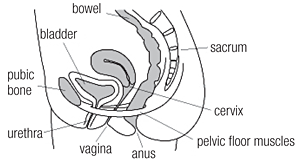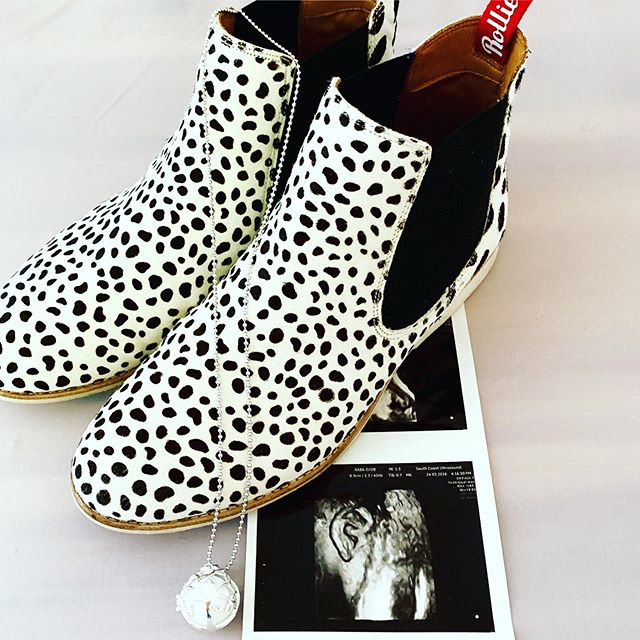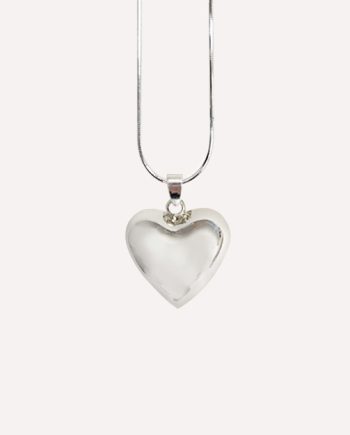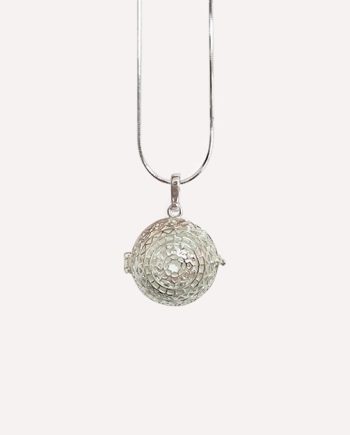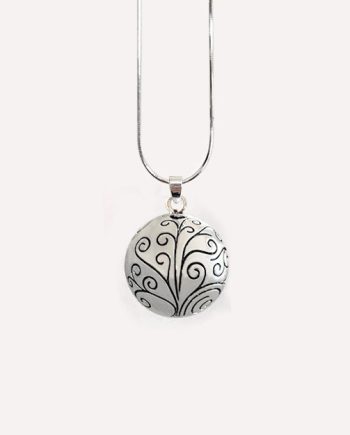
3 Pelvic floor exercises you need to start doing right now
May 27, 2019I remember it vividly. Merely an hour after delivering my first baby, the Midwife kindly informed me that it was time to start pelvic floor exercises, and work on restrengthening my Pelvic Floor. “Keep it simple at this stage” she said, “Each time you go to the toilet in the coming days, try and stop the flow of urine after the first 3 or 4 seconds, hold it for a few seconds before starting the flow again”.
“Right, go it” I replied, confident this would be a piece of cake. So when natured next called, I started to pee.. 2, 3, 4, Stop!
And absolutely nothing happened.
What is the Pelvic Floor
The pelvic floor is a group of muscles and ligaments that support the bladder, uterus (womb) and bowel.
The openings from these organs, the urethra from the bladder, the vagina from the uterus and the anus from the bowel pass through the pelvic floor. The pelvic floor muscles attach to your pubic bone at the front and the tail bone at the back and from the base of your pelvis.
When the pelvic floor is strong, it supports the pelvic organs to prevent problems such as:
- incontinence (the involuntary loss of urine or faeces)
- prolapse (lack of support) of the bladder, uterus and bowel.
The pelvic floor muscles also help you to control bladder and bowel function, such as allowing you to ‘hold on’ until an appropriate time and place2.
Pelvic Floor Exercises
Pelvic floor exercises help to strengthen the muscles of the pelvic floor. These muscles come under great strain in pregnancy and childbirth1.
If your pelvic floor muscles are weakened, you may find that you leak urine when you cough, sneeze, strain or jump on the trampoline! 🙂 This is quite common and you needn’t feel embarrassed.
By performing pelvic floor exercises, you can strengthen the muscles.
3 Pelvic floor exercises you need to start right now
These exercises are perfect for women of all ages and at every life stage. Pregnant, postpartum, small children, adult children, no children! #selfcare
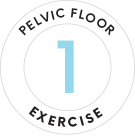
Exercise 1: Long hold for strength
Step 1:
Sit, stand tall, lie on your back with your knees bent and legs comfortably apart or kneel on your hands and knees.
Step 2:
Close your eyes, imagine what muscles you would tighten to stop yourself from passing wind or to ‘hold on’ from passing urine. If you can’t feel a distinct tightening of these muscles, please speak/seek help from your local women’s health physiotherapist.
Step 3:
Now that you can feel your pelvic floor muscles working, tighten them around your front passage, vagina and back passage as strongly as possible and hold for three to five seconds. By doing this, you should feel your pelvic floor muscles ‘lift up’ inside you and feel a definite ‘let go’ as the muscles relax. If you can hold longer (but no more than a maximum of eight seconds), then do so. Remember, the squeeze must stay strong and you should feel a definite ‘let go’. Repeat up to ten times or until you feel your pelvic floor muscles fatigue. Rest for a few seconds in between each squeeze.
Note: Steps one to three count as one exercise set. If you can, do three sets per day in different positions. Do your pelvic floor exercises every day for the rest of your life.
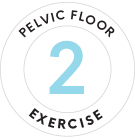
Exercise 2: Squeeze and lift
Source: Continence Australia
- Squeeze and draw in the muscles around your back passage and your vagina at the same time. Lift them UP inside. You should have a sense of “lift” each time you squeeze your pelvic floor muscles. Try to hold them strong and tight as you count to 8. Now, let them go and relax. You should have a distinct feeling of “letting go”.
- Repeat “squeeze and lift” and let go. It is best to rest for about 8 seconds in between each lift up of the muscles. If you can’t hold for 8, just hold for as long as you can.
- Repeat this “squeeze and lift” as many times as you can, up to a limit of 8 to 12 squeezes.
- Try to do three sets of 8 to 12 squeezes each, with a rest in between.
Do this whole training plan (three sets of 8 to 12 squeezes) each day while lying down, sitting or standing.
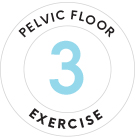
Exercise 3: Quick squeeze for power
Squeeze and lift your pelvic floor muscles as strongly and as quickly as possible. Do not try to hold on to the contraction, just squeeze and let go. Rest for a few seconds in between each squeeze. Repeat this 10 to 20 times or until you feel your pelvic floor muscles fatigue.
If you can, do this exercise set one to three times per day.
During both exercises you should:
- feel your pelvic floor muscles ‘lift up’ inside you, rather than feel a downward movement
- relax your thighs and buttocks
- keep breathing normally
- stop exercising if your muscles fatigue.
Not sure where your pelvic floor is, or how to tone it once you’ve found it? Watch Dr Marg Sherburn from the Women’s as she demonstrates how to take care of those pelvic muscles.
Useful resources for exercising pelvic floor muscles
Source: Pelvic Floor First
Remembering to do your Pelvic Floor Exercises
This great free App from Continence Australia, called the The Pregnancy Pelvic Floor Plan App.
Schedule alerts/reminders to complete your exercises, three times per day, and access useful information.
- Tips on looking after your pelvic floor, bladder and bowel during pregnancy
- Learn how to do pelvic floor exercises and receive reminders
- Information about safe exercise during and after pregnancy
- Health and wellbeing tips on looking after yourself
- Find local services for pelvic floor problems
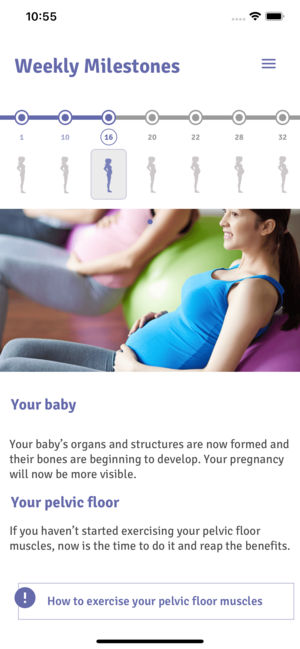
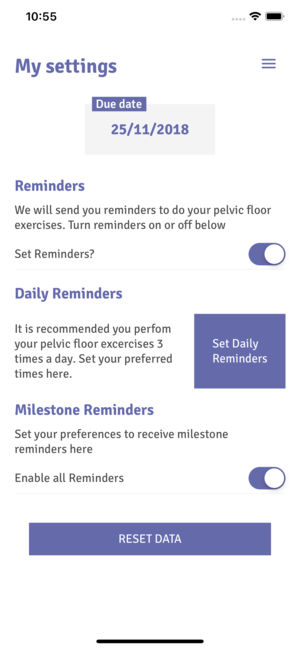
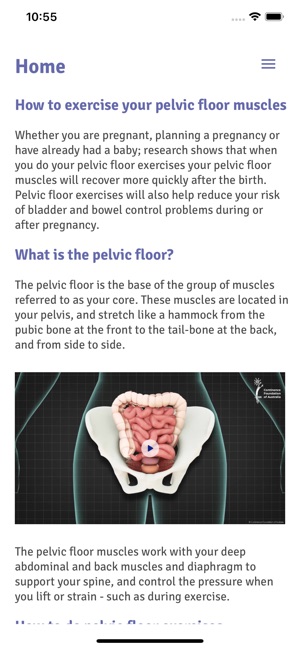
Blog posts you may also like..
Pregnancy gifts for expectant mothers

